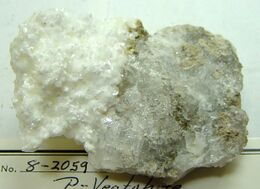Chemistry:Veatchite
From HandWiki
| Veatchite | |
|---|---|
 Veatchite-p, Billie Mine, Death Valley, California | |
| General | |
| Category | Phylloborates |
| Formula (repeating unit) | Sr2B11O16(OH)5 · H2O |
| Strunz classification | 6.EC.15 |
| Crystal system | Monoclinic |
| Crystal class | Domatic (m) (same H-M symbol) |
| Space group | Aa |
| Unit cell | a = 20.81 Å, b = 11.74 Å c = 6.63 Å; β = 92.03°; Z = 8 |
| Identification | |
| Color | Colorless to white |
| Crystal habit | Flattened platey to prismatic crystals, diverging fibrous clusters and cross fiber veinlets |
| Cleavage | Perfect on {010}, indistinct on {001} |
| Mohs scale hardness | 2 |
| |re|er}} | Vitreous to pearly |
| Diaphaneity | Transparent to translucent |
| Specific gravity | 2.62 |
| Optical properties | Biaxial (+) |
| Refractive index | nα = 1.551 nβ = 1.553 nγ = 1.620 |
| Birefringence | δ = 0.069 |
| 2V angle | Measured: 37° |
| References | [1][2][3] |
Veatchite is an unusual strontium borate, with the chemical formula Sr2B11O16(OH)5·H2O. There are two known polytypes, veatchite-A and veatchite-p.[5]
Veatchite was discovered in 1938, at the Sterling Borax mine in Tick Canyon, Los Angeles County, California . Veatchite is named to honor John Veatch, the first person to detect boron in the mineral waters of California.
See also
References
- ↑ Veatchite on Mindat.org
- ↑ Veatchite data on Webmineral
- ↑ Veatchite in the Handbook of Mineralogy
- ↑ Warr, L.N. (2021). "IMA–CNMNC approved mineral symbols". Mineralogical Magazine 85 (3): 291–320. doi:10.1180/mgm.2021.43. Bibcode: 2021MinM...85..291W.
- ↑ Grice J D, Pring A (2012) Veatchite: structural relationships of the three polytypes, American Mineralogist 97, 489-495
External links
 |
